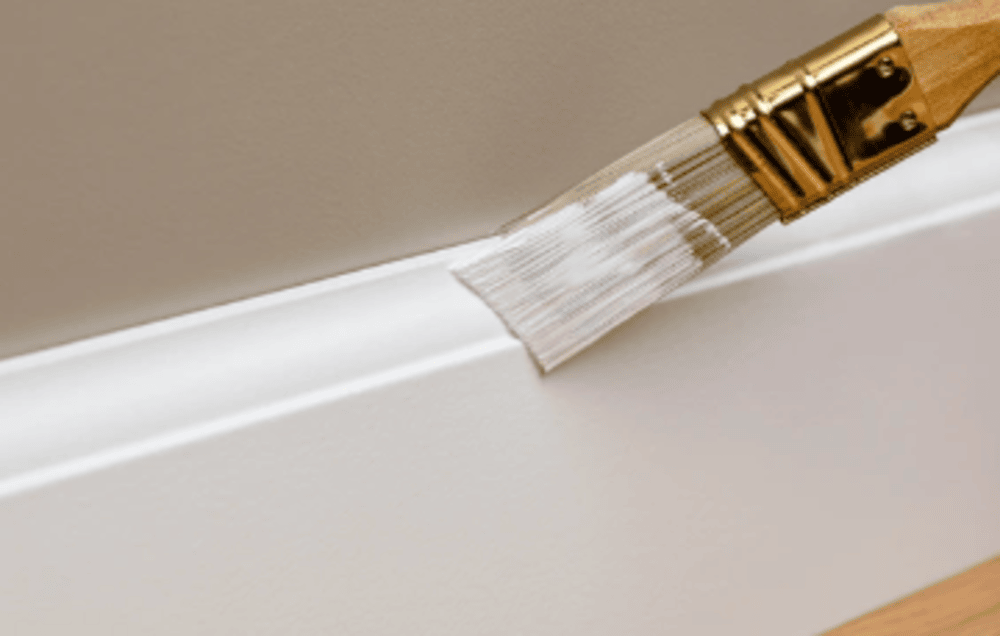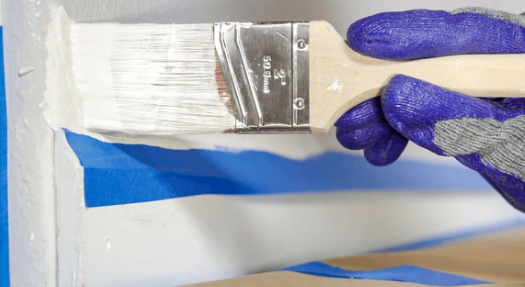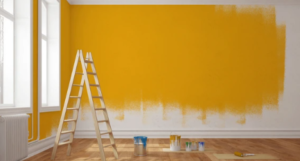
Baseboard Painting: Quick Fixes for Chipped and Scuffed Paint
Table of Contents
Key Takeaways
✔ Determine whether the damage is minor enough for a touch-up or if a full repaint is necessary.
✔ Clean, sand, and select the correct paint to ensure proper adhesion and color match.
✔ Use painter’s tape and protective materials to achieve crisp lines and prevent paint bleed.
✔ Choose between a brush for control or a spray for speed and smooth coverage.
✔ Look for local professional baseboard painters with a track record of quality results.
✔ Keep baseboards clean, inspect regularly, and address minor chips early to extend the finish.
Freshly painted baseboards give any room a crisp, finished look, but chips and scuffs from daily wear can quickly dull their appeal. These small flaws are common but easy to fix without a full repaint. With the right prep, tools, and techniques—plus knowing when to call in the pros—baseboards can look sharp again in no time.
In fact, interior painting offers an average return on investment (ROI) of about 107%, potentially adding $2,140 to $16,050 or more in resale value.
Here are quick fixes for chipped and scuffed baseboard paint that offer professional-looking results.
Quick Fixes for Chipped Baseboard Paint: A How-To
Assess the Damage
Baseboards add a clean, finished look to a room, but they’re often the first surfaces to show wear and tear. Before painting begins, it’s essential to understand what kind of damage is present and how extensive it is.
Understanding Chips vs. Scuffs
Baseboard damage comes in different forms. Recognizing the type of wear makes it easier to apply the right solution.
- Paint Chips: These are caused by impacts, sharp objects, or moisture and can expose the wood or primer beneath. Fixing them usually involves sanding, priming, and repainting—tasks best handled by trim and baseboard painting services for a clean finish.
- Scuff Marks: Scuffs are surface marks from shoes, furniture, or cleaning tools and often don’t break the paint. They can usually be wiped off or touched up, though frequent scuffing may require a tougher paint finish.
Choosing Between Touch-Up and Full Repaint
Once the type of damage is identified, it’s time to decide on the scale of the repair. This depends on how visible and widespread the flaws are.
- Touch-Up: Small chips or scuffs can be fixed with light sanding and a bit of original paint, making it a quick option for those seeking baseboard painting near me in Southbury, CT.
- Full Repaint: Widespread damage, peeling, or mismatched color calls for a full repaint, best handled by trim and baseboard painting services for a smooth, lasting finish.
Prepare for Touch-Ups or Repainting
Baseboards are prone to chips, scuffs, and fading due to daily wear and tear. Whether touching up a small area or planning a full repaint, proper preparation ensures long-lasting results.
Cleaning and Sanding the Surface
A clean and smooth baseboard is essential for paint to bond correctly. Skipping this step often leads to patchy results or paint that peels quickly.
- Remove Dust and Dirt: Use a damp cloth or sponge to wipe down the baseboards, especially along edges where dust collects. Dirt and debris can prevent even coverage, making the final paint look blotchy.
- Degrease Stubborn Areas: In high-traffic areas or near kitchens, apply a gentle degreaser to break down oils and residue. This helps paint stick properly and prevents early peeling.
- Sand for Smoothness: Lightly sand chipped, glossy, or rough areas with fine-grit sandpaper. This removes old paint layers and smooths out any raised sections for a more uniform surface.
- Vacuum or Wipe After Sanding: Once sanding is done, remove all dust using a vacuum attachment or a tack cloth. Leftover dust can cause bumps or interfere with how well the new paint adheres.
Choosing the Right Paint Finish and Color Match
Choosing the right paint makes a major difference in how well the baseboards hold up. A well-matched color and a durable finish help maintain a clean, professional appearance.
- Choose Durable Finishes: Semi-gloss and satin finishes are best for baseboards because they’re easier to clean and more resistant to marks and scuffs. These finishes are commonly used by professional baseboard painters for their long-term durability.
- Color Matching Matters: For small touch-ups, use a leftover paint can or bring a paint chip to a hardware store for matching. A near-perfect match keeps the repair discreet and prevents patchy results.
- Use Interior-Grade Paint: Interior trim paint is designed for hard surfaces and daily contact. Choosing paint made specifically for trim and doors ensures smoother application and better wear over time.
Do Masking Techniques for Clean Edges
A smooth, clean edge can make a big difference in the final look of any baseboard paint job. Whether it’s a quick touch-up or a full repaint, good masking techniques help avoid messy lines, paint bleed, and uneven finishes.
Choosing the Right Masking Tools
To achieve crisp lines and protect surrounding surfaces, selecting the right tools is essential. Many professional baseboard painters rely on these items for accuracy.
- Painter’s Tape: Specifically designed to seal out paint while being easy to remove. It helps define a clean line between the baseboard and the wall or floor.
- Drop Cloths: Protects flooring from accidental spills or drips. Ideal for hardwood, tile, or carpeted surfaces during painting.
- Edge Guards or Paint Shields: Helpful for quick touch-ups when taping is not practical. They act as a physical barrier between the paint and adjacent surfaces.
Step-By-Step Masking Process for Baseboards
After cleaning the surface, executing eac
h step with care ensures better results and minimizes the need for corrections later. Many professionals offering trim and baseboard painting services follow a consistent process like this:
- Measure and Apply Tape Precisely: Place painter’s tape flush along the top edge of the baseboard and the bottom if needed. Use small sections for more control in corners and uneven areas.
- Seal the Tape Edges: Firmly press down the tape using a putty knife or flat tool. This helps prevent paint from seeping underneath.
- Position Drop Cloths Correctly: Tuck cloths tightly along the baseboards to cover flooring completely. Avoid plastic sheeting as it can be slippery and shift during painting.
- Double Check Alignment: Before painting, ensure all tape and cloths are secure and straight. Re-adjust any areas that look loose or uneven.
Avoiding Common Paint Bleed and Edge Issues
Uneven lines and paint bleed can happen, even with tape. A few preventative steps can make a major difference in the final finish.
- Don’t Overload the Brush: Excess paint can drip or seep under the tape. A lightly loaded brush provides better control and reduces waste.
- Paint Away from the Tape Line: Stroking the brush or sprayer away from the edge instead of toward it helps avoid pushing paint beneath the tape.
- Remove Tape at the Right Time: Peel tape off slowly at a 45-degree angle before the paint fully dries. This reduces the chance of peeling paint or jagged edges.
Choose the Correct Tools & Techniques
Choosing between a brush and a spray when painting baseboards depends on the condition of the trim, the size of the job, and the desired finish. Each method has its strengths and drawbacks, and both can produce excellent results when used correctly.
Pros and Cons of Brush Painting
Brush painting is a classic and widely used technique, especially for smaller or detailed baseboard areas. It offers more control, especially around corners and edges, which makes it suitable for homes with intricate trim work.
Pros
- Precision in Tight Areas: Ideal for detailed baseboards and tight spaces where control is needed for accuracy.
- Less Overspray Risk: Reduces the chance of paint getting on floors or walls, which is particularly helpful when masking techniques for clean edges are limited.
- Lower Equipment Cost: Requires basic tools like brushes and painter’s tape, making it affordable and accessible for small touch-ups.
Cons
- Slower Process: May take longer to complete compared to spraying, especially for larger areas or full-room trim projects.
- Visible Brush Marks: Can leave slight brush strokes, which may not be ideal for those wanting a smooth, factory-like finish.
Pros and Cons of Spray Painting
Spray painting offers a sleek, modern look and is often used by professional baseboard painters for faster, more uniform coverage. It works best in areas where furniture and flooring can be thoroughly masked or covered.
Pros
- Fast Coverage: Allows large areas to be painted quickly, saving time during whole-house baseboard projects.
- Smooth, Even Finish: Delivers a consistent, high-quality result with no visible brush strokes, ideal for a modern aesthetic.
Cons
- Requires Careful Prep: Demands extensive masking techniques for clean edges to protect adjacent surfaces from overspray.
- Higher Equipment Cost: Involves specialized tools such as paint sprayers and protective gear, which may not be cost-effective for minor repairs.
- Ventilation Considerations: Produces fine particles in the air, requiring good airflow and protective masks during use.
When to Choose Brush vs. Spray for Baseboards
Each technique serves its own purpose depending on the project size, environment, and desired outcome, and understanding brush vs. spray painting baseboards helps ensure a cleaner, more professional finish.
When to Choose Brush Painting
Small jobs, trim with curves or grooves, or homes where minimal masking is preferred. Especially useful when baseboards are already installed and homeowners are living in the space.
When to Use Spray Painting
Large or new spaces, smooth finishes, or when baseboards are detached. Also preferred when timelines are tight and a flawless finish is the goal.
When to Use Both
Many trim and baseboard painting services use both methods—brushes for corners and details, spray for long straight runs—for efficiency and precision.
Hire the Right Help
Finding the right team for trim and baseboard painting can make all the difference in how the final results look and last. With chipped or scuffed baseboards, a professional approach ensures durability and a clean, polished finish.
Using “Baseboard Painting Near Me” to Find Local Options
Finding qualified painters in the area is easier with the right search terms. Using location-based keywords can help narrow down reliable options quickly.
- Use Location-Specific Keywords: Typing baseboard painting near me in Southbury, CT, into search engines or review platforms pulls up professionals in the immediate area, often ranked by ratings and distance.
- Explore Local Listings and Directories: Sites like Yelp, Angi, or Google Business provide verified reviews, service details, and contact information, making it easier to compare providers side by side.
- Reach Out to Local Hardware Stores: Local paint or hardware shops often keep a list of trusted painters in the community. These referrals can be a reliable resource for finding professional baseboard painters.
How to Evaluate Trim and Baseboard Painting Services
Locating a skilled and dependable service provider starts with a clear understanding of what to look for and where to look. Homeowners benefit from doing a bit of research before hiring.
- Check Online Reviews and Portfolios: Look for companies with consistent positive feedback and a visual track record of completed projects. Photos of their work provide insight into quality and attention to detail.
- Ask About Specific Experience: Not all painters specialize in trim and baseboards. It’s important to confirm that a provider offers trim and baseboard painting near you specifically, as this requires more precision than general wall painting.
- Request a Detailed Estimate: A clear, written estimate should include surface preparation, the painting method (such as brush vs. spray painting baseboards), and cleanup. This helps prevent hidden fees and sets expectations.
- Inquire About Techniques Used: A good sign of quality is when painters explain their process, especially when they mention using masking techniques for clean edges. This shows a focus on delivering sharp, professional-looking lines.
What to Expect from Professional Baseboard Painters
Choosing professional baseboard painters brings several benefits, especially when a flawless, lasting finish is the goal. Understanding their workflow can help manage expectations.
- Thorough Preparation: Surfaces will be cleaned, lightly sanded, and masked to protect flooring and walls. Proper prep is essential to help paint adhere and avoid peeling later.
- Expert Application: Professionals will choose the best method for each space, whether using brushes for detailed work or sprayers for larger areas, factoring in brush vs. spray painting baseboards for optimal results.
- Attention to Detail: Skilled painters take time to ensure even coverage, clean corners, and smooth edges. Use of masking techniques for clean edges helps deliver crisp, professional lines.
- Clean and Timely Completion: Jobs are completed on schedule, and cleanup is handled thoroughly—leaving no drips, tape, or debris behind.
Perform Maintenance After Painting
Once baseboards have been freshly painted, keeping them in good shape is essential. Chips, scuffs, and wear can quickly return without the right care. Simple maintenance can help extend the life of the paint job and keep the space looking neat and well-kept.
Preventing Future Chips and Scuffs
Daily activity can take a toll on painted baseboards. Preventative steps help maintain a smooth finish and reduce the need for frequent touch-ups.
- Add Protective Furniture Pads: Attach felt or rubber pads under furniture legs to reduce impact when items are moved across the floor.
- Keep High-Traffic Areas Clear: Avoid placing furniture too close to baseboards in busy areas to reduce accidental contact.
- Train Pets and Children: Teaching pets and young children to avoid scraping or bumping walls can go a long way in preserving the finish.
Cleaning Baseboards Properly
Dust, grime, and scuff marks can make baseboards look dull, even when the paint is still intact. Cleaning them the right way can restore their look without causing damage.
- Use Soft Cloths or Sponges: Gentle materials help prevent surface scratching or paint peeling. Avoid abrasive scrubbers.
- Mild Soap and Water Solution: A small amount of dish soap in warm water can effectively remove dirt. Make sure to wring out excess moisture before wiping.
- Dry Thoroughly After Cleaning: Moisture left behind can weaken paint over time. A dry microfiber cloth works best for finishing.
Regular Inspection and Minor Touch-Ups
Small chips or nicks often go unnoticed until they worsen. Regular check-ins allow early fixes that maintain a polished look.
- Inspect Baseboards Every Few Months: A quick walk-through of the home can help identify trouble spots before they spread.
- Keep Extra Paint On Hand: Matching the original color and finish is easier when leftover paint is stored properly.
Frequently Asked Questions
What do professionals use to paint trim?
Professionals typically use high-quality, semi-gloss or satin latex paint for trim, along with angled brushes or fine-finish sprayers for precision. They often rely on masking techniques for clean edges to achieve crisp lines and prevent bleeding. High-tack painter’s tape, drop cloths, and sanding tools are also standard in their setup.
How much does it cost to get baseboards painted?
The cost to paint baseboards usually ranges from $1 to $3 per linear foot, depending on the condition of the trim, paint type, and labor involved. Larger homes or custom finishes may increase pricing. However, costs can vary by region and provider, so it’s recommended to check with reputable companies like Southbury House Painting Experts for accurate estimates and professional guidance.
Is painting baseboards worth it?
Painting baseboards is a cost-effective way to refresh a space and give it a polished appearance. It covers wear, enhances wall and floor transitions, and adds value to both new and older interiors. Regular painting can also protect trim from moisture and damage. For best results, many turn to professional baseboard painters like Southbury House Painting Experts to ensure a long-lasting finish.
Is it better to paint baseboards with a brush or roller?
A brush is usually better for baseboards because it offers greater control around edges and tight spots. However, for longer runs of trim, some professionals use a small foam roller for speed and even coverage.
How to paint baseboards without leaving brush marks?
To avoid brush marks, professionals use high-quality angled brushes, apply thin coats, and lightly sand between applications. A smooth, clean surface is key, and using a paint conditioner can also help the paint level out. Steady strokes in one direction reduce streaks.
Protect and Refresh Baseboards with Expert Painting in Southbury, CT!
Keep baseboards looking flawless with precision painting handled by experienced professionals. Scuffed edges, chipped paint, and uneven finishes can be eliminated with help from Southbury House Painting Experts, offering reliable trim and baseboard painting services in Southbury, CT. For anyone searching for dependable baseboard painting near me in Southbury, CT, expert solutions are available right here.
Contact Southbury House Painting Experts today to schedule a baseboard refresh!



